Upgrading and Analyzing Apple's Nehalem Mac Pro
by Anand Lal Shimpi on July 13, 2009 5:00 PM EST- Posted in
- Mac
Upgrading the CPUs in the Nehalem Mac Pro
Let’s say you get over the $3299 price tag of the 8-core Mac Pro but aren’t really happy with the paltry 2.26GHz clock speed of the quad-core Nehalems in the box. Apple offers two upgrades: a pair of 2.66GHz or 2.93GHz Nehalems, how nice of them. The 2.66GHz upgrade will set you back $1400, while the 2.93GHz upgrade will basically cost you another Mac Pro at $2600.
To Apple’s credit, these CPUs are expensive. Here is Intel’s pricing:
| CPU | Intel's Price for Two CPUs | What Apple Charges for Two (BTO Upgrade) |
| Intel Xeon X5570 | $2772 | $2600 |
| Intel Xeon X5550 | $1916 | $1400 |
| Intel Xeon E5520 | $746 | |
| Intel Xeon W3540 | $1124 | $1000 |
| Intel Xeon W3520 | $568 |
A single Xeon X5570 costs $1386, Apple is charging you $2600 for two - but that’s on top of the base cost of the 8-core Mac Pro; you’re effectively paying for the two Xeon E5520 chips and the two X5570s, but only getting the latter.
The same applies to the single-chip Mac Pro. The only CPU upgrade offered there is the Xeon W3450; retail cost is $562, Apple’s benevolent self will only charge you $500.
I should also point out the sheer ridiculousness of Apple putting a pair of $373 CPUs in a $3300 machine. I get that Apple wants to commoditize everything that they don’t make, but that’s just ridiculous.
Do you smell motivation? Because I do.
If you don’t mind voiding your warranty, you are better off buying the base Mac Pro (4 or 8 core) configuration, upgrading the CPUs yourself and ebaying the originals.
The even more sensible option would be to wait a while and upgrade the Xeons once these ones fall in price.
Regardless of when or why you want to do it, I figured we should give it a try. They built sockets for a reason after all.
Voiding the Warranty
Getting inside the new Mac Pro is much easier than the old one. Remove the side panel then unlatch and remove the processor tray and you’ve got this:
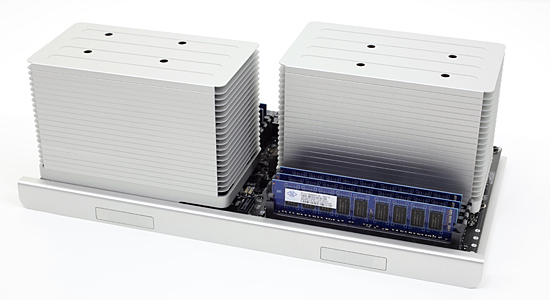
Two towering heatsinks, eight DIMM slots an X58 chipset are the main attractions. Remember all of the hoopla a few pages ago about Turbo Mode? That’s the reason for these beefy heatsinks; there’s actually a fan inside each heatsink, as well as two large fans moving air across the entire board in the case.

The heatsinks have an integrated fan and thermal sensor (black cable)
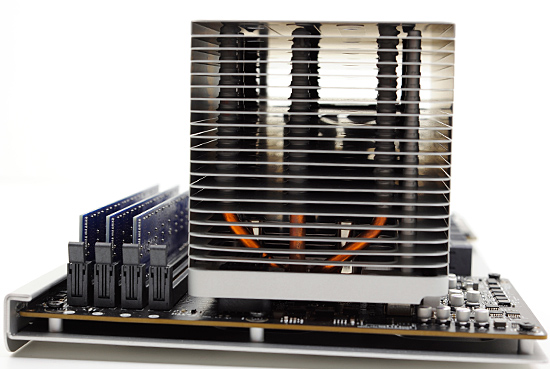
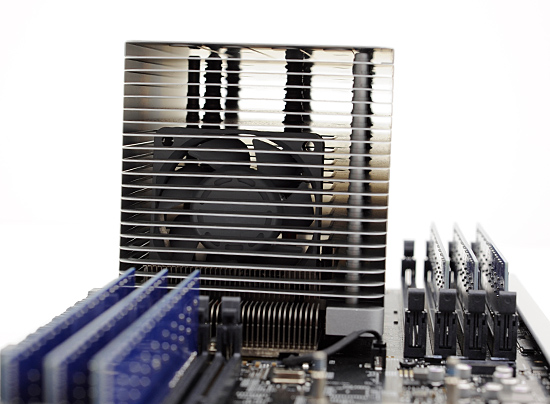
There are four screw holes at the top of the heatsink. Apple actually made removing the heatsinks very easy, all you need is a long 3mm hex key - about 3” long (plus a handle) should suffice.
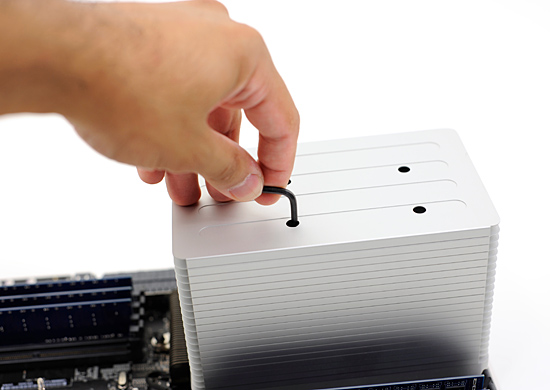
Stick the hex key in any one of the holes, move it around until it grabs, and then unscrew. Rinse and repeat. The screws are attached to the heatsink and spring loaded; you don’t have to physically remove any, just wait until they pop up.
With all four screws removed you can just lift the heatsink straight up. The CPU sockets don’t have clamps, so the chip will most likely lift out of the LGA socket attached to the heatsink.
Carefully twist and pull the CPU until it comes off of the heatsink and you’ll be greeted with the first surprise from Apple: the 8-core Mac Pro ships with lidless Nehalems.
Normally a Core i7 or Xeon processor will look like this:
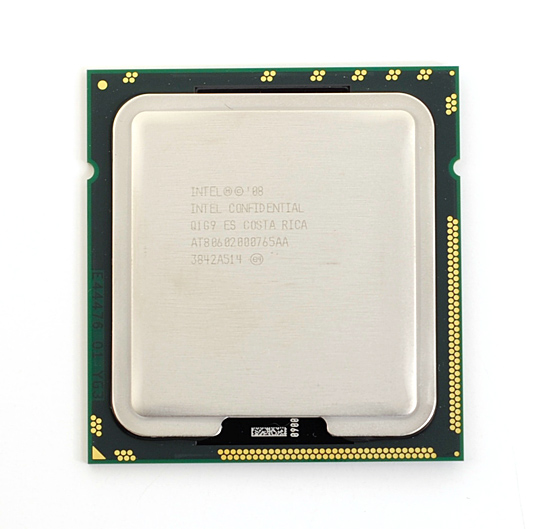
But the 8-core Mac Pro uses specially sourced parts from Intel that have no integrated heat spreader (IHS):

No lid, all Nehalem.
This is obviously a cooling play. The IHS is useful in preventing cracked cores from improperly installed heatsinks, but it does make cooling more difficult. With the heatsink flush against the bottom of the Nehalem die, it can remove heat faster from the chip. More efficient cooling results in lower CPU temperatures and lower fan speeds.
The lidless Nehalems are only used in the 8-core version as far as I can tell. The standard quad-core Nehalem Mac Pro uses regular Xeons with an integrated heat spreader.
The lidless Nehalems do provide a challenge: you can’t buy them. You have to buy a standard, lidded Nehalem Xeon and either remove the IHS or leave it intact and hope it works well. The first option isn’t a very good one; while removing a heat spreader isn’t impossible, you do run the risk of destroying your $1400 CPU. The second option, if it works, is the safest route.
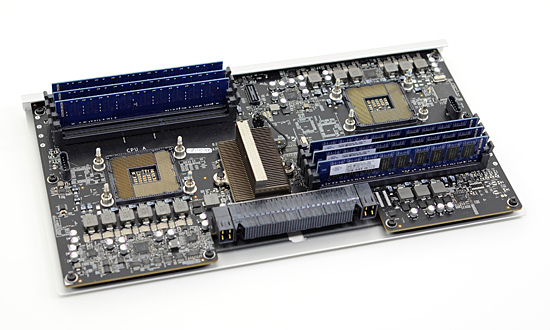
We got a pair of Xeon X5570s and tried to install them, with heat spreaders and all, in our 8-core Mac Pro. Simply pull one chip out, replace it, apply thermal grease, remount the heatsink and screw it back in...or so we thought.
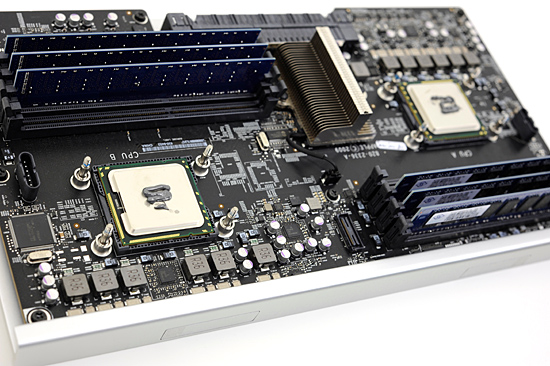
The lidless Nehalems were out, the new lidded processors should work - they should just be a bit more difficult to cool










58 Comments
View All Comments
jamesst - Tuesday, July 14, 2009 - link
"The Lexar reader is FireWire 800 (woo!) and the iSight is FireWire 400; I can’t use the iSight on the new Mac Pro."You can still use your Firewire 400 iSight camera on the Mac Pro's Firewire 800 ports. All you need is a Firewire 400 to Firewire 800 cable. I know that Belkin makes just such a cable and I even purchased one at my local Apple Store here in Raleigh, NC.
joelypolly - Monday, July 13, 2009 - link
I have actually had something similar happen to a socket I was working on. It was a matter of finding a sewing needle and moving each "pin" back to the original position.HilbertSpace - Monday, July 13, 2009 - link
It would be interesting to try swapping the 2-socket tray with a 1-socket Mac Pro, and see if it works(?) Would be cheaper to buy the 2-socket board and upgrade yourself, no?MonkeyPaw - Monday, July 13, 2009 - link
Are FB-DIMMs going to disappear from the market? While at first it doesn't sound Mac-related, original MacPro owners might soon be running out of memory upgrade options (though I doubt they've held out this long to upgrade). It wasn't cheap to start with, but it seems like it was Band-Aid technology. The IMC was the answer, but FB-DIMMs were a stop-gap until Nehalem-Xeons could arrive. Perhaps a memorial article for the technology is needed?JimmiG - Monday, July 13, 2009 - link
Ok so I get it, even the "cheap" Mac Pro uses a Xeon, not an i7... But for all intents and purposes, it's an i7 920.Who in their right mind would pay $2,500 for a i7 920 system with 3GB of RAM, 640GB HDD and a rebranded Geforce 9500 GT? You can build a similar PC (or hackintosh) with the same specifications for the a fraction of the price - in fact you could also bump the RAM to 6GB and throw in a 1TB drive and a 4870 1GB or 4890 if you wanted and still stay *well* below that price point, even if using quality components and case.
The Mac Pro isn't even shiny!
plonk420 - Tuesday, July 14, 2009 - link
did you read page 10?MrDiSante - Thursday, July 16, 2009 - link
Did you read his comment?ltcommanderdata - Monday, July 13, 2009 - link
Another great in depth review. Your experiences with upgrading the processors were particularly interesting although I don't think it'd be something I would try.I just wanted to suggest you Boot Camp the Mac Pro and run the benchmarks needed to add 2x2.26GHz Gainestown and 2x2.93GHz Gainestown results to the Anandtech Bench. It might also be interesting to get a sample of the new nVidia GTX285 Mac Edition. It would certainly address the 1GB of VRAM concerns and would be cheaper than getting the HD4870 if you need 2 dual-link DVI ports since you don't need to buy that finicky adapter. There really aught to be DVI to mini-DP adapters though for people who still want to use the 24" LED display.
http://www.glbenchmark.com/result.jsp">http://www.glbenchmark.com/result.jsp
Oh and for interest, there turns out to be a 3D benchmark comparing the various iPhones to other cell phones. It's called GLBenchmark and needless to say, the iPhone 3G S is a screamer. They are also detecting the iPhone 3G S GPU as a PowerVR SGX 535.
ddobrigk - Monday, July 13, 2009 - link
Actually, the Nehalem-EX's octo-core possibility is a no-go for now. It is a future product and has not been launched yet.Also, a little bit of nitpicking, but it won't use LGA1366 like these Xeons, it'll use LGA1567, because each CPU will sport a 4-channel memory controller.
In addition, it'll sport 4 QPI links, and its intended target are 4-way and 8-way systems, not really 2-way systems. A few rumors exist about some integrators being interested in 2-socket systems, though we're still a few months from actually seeing any LGA1567 motherboard on display, AFAIK. All we saw was an Intel Demo about it.
Don't know if Apple intends to go with 2-socket nehalem-exs, anyway, because when Nehalem-EX really hits the market, there'll also be the 6-core westmeres, I think. In any case, we're way beyond a reasonable number of cores for the typical user. :D
BrianMCan - Friday, July 17, 2009 - link
MacPro's really aren't meant for typical users ;)Scientific, Video/Movies, 3D, and advanced users who may do many things including the already mentioned, or many things at once. Always other things I can be doing while some video is rendering, including playing some Civ 4, or starting the next video project, researching upgrades & repairs for customers, stuff like that.
Although I personally may wait for the 2nd gen Nehalem MacPro's before I upgrade from my first gen MacPro, other than raw processing power, it does most of what I need efficiently enough.